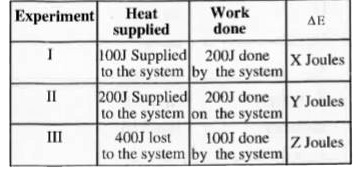A chamber contains 77gofCO2. The chamber was divided into three compartments X, Y and Z as shown below. Suggest the relation between the internal energies of the gas in the three compartments X, Y and Z.
X 11gCO2 y22gCO2 Z44gCO2Solution in Telugu
Under similar conditions the internal energy of a given substance depends on its quantity because it is an extensive property. The internal energies of CO2 in the compartments X, Y and Z are in the ratio 1:2:4.
Topper's Solved these Questions
- BOOK - AAKASH SERIESCHAPTER - CHEMICAL THERMODYNAMICSEXERCISE - SUBJECTIVE EXERCISE- 1 (LONG ANSWER QUESTIONS)2videos
CHEMICAL THERMODYNAMICS
- BOOK - AAKASH SERIESCHAPTER - CHEMICAL THERMODYNAMICSEXERCISE - SUBJECTIVE EXERCISE- 1 (SHORT ANSWER QUESTIONS)13videos
CHEMICAL THERMODYNAMICS
- BOOK - AAKASH SERIESCHAPTER - CHEMICAL THERMODYNAMICSEXERCISE - ADDITIONAL PRACTICE EXERCISE (PRACTICS SHEET (ADVANCED) INTEGER TYPE QUESTIONS)3videos
CHEMICAL THERMODYNAMICS
- BOOK - AAKASH SERIESCHAPTER - CHEMICAL THERMODYANMICS EXERCISE - Questions For Descriptive Answers28videos
CHEMICAL THERMODYANMICS
- BOOK - AAKASH SERIESCHAPTER - ELECTRON MIGRATION EFFECTS EXERCISE - QUESTIONS FOR DESCRIPTIVE ANSWERS10videos
ELECTRON MIGRATION EFFECTS
Similar Questions
What are the types of systems? Explain give one example each?
02:50View SolutionWhat are intensive and extensive properties?
01:58View SolutionCalculate the pH at which the following conversion (reacton ) will be at equilibrium in basic medium I2(s)⇔I−(aq)+IO−3(aq). When the equilibrium concentrations at 300 K are [I−] = 0.10 and [IO−3]=0.10M Given that ΔG0f(I−aq)=−50 kJ/mole, ΔG0f(IO−3,aq)=−123.5kJ/mole,ΔG0f(H2O,l)=−233 kJ/mole, ΔG0f(OH−,aq)=−150 kJ/mole, Ideal gas constant =R=253Jmole−1K−1, log e = 2.3,
06:51View SolutionHow does heat of neutralisation value change with the chemical nature of acid and base?
02:32View SolutionHyperconjugation effect is also termed as 'no bond resonance'. Why?
View SolutionIf A = {x, y, z}, then the relation
R={(x,x),(y,y),(z,z),(z,x),(z,y)}, is02:04View SolutionN_2+H_2rarr[X](g)overset(CO_2,"Pressure")rarr[Y]overset("Heat")rarr[Z]+H_2O In the above sequence of reaction, [Y] and [Z] are respectively.
01:12View SolutionThree positive distinct numbers x,y,z are three terms of geometric progression in an order , and the number x+y,y+z,z+x are three terms of arithmetic progression in that order . Prove that xx.yy.zz=xy.yz.zx
01:47View SolutionFrom the observations given below, suggest the relation between X,Y and Z
04:15View SolutionCO2 gas along with solid (Y) is obtained when sodium salt (X) is heated. (X) is again obtained when CO2 gas is passed into aqueous solution of (Y). (X) and (Y) are respectively
04:34View SolutionFrom the observations given below, suggest the relation between X, Y and Z
 03:50View Solution
03:50View SolutionA chamber contains 77gofCO2. The chamber was divided into three compartments X, Y and Z as shown below. Suggest the relation between the internal energies of the gas in the three compartments X, Y and Z.
X 11gCO2 y22gCO2 Z44gCO202:30View Solution22g of CO2 at STP will occupy :
01:08View SolutionThe compound X on heating gives a colourless gas. The residue is dissolved in water to obtain Y Excess CO2 is bubbled through aqueous solution of Y, Z is formed. Z on gentle heating gives back X. The compound X is:
02:30View SolutionX+,Y2+ एवं Z− आयन CO2 के समइलेक्ट्रॉनिक हैं। इनमें प्रोटॉन की संख्या का क्रम होगा
View Solution
